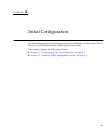
1-6 Sun Fire B1600 Blade System Chassis Switch Administration Guide • June 2003
1.3 Features of the Switch
The switch provides a wide range of advanced performance-enhancing features.
Multicast filtering provides support for real-time network applications. Port-based
and tagged virtual local area networks (VLANs), plus support for automatic GARP
VLAN Registration Protocol (GVRP) provides traffic security and efficient use of
network bandwidth. Quality of Service (QoS) priority queueing ensures the
minimum delay for moving real-time multi-media data across the network. Flow
control eliminates the loss of packets due to bottlenecks caused by port saturation.
And broadcast storm suppression prevents broadcast traffic storms from engulfing
the network. Some of the management features are briefly described in this section.
■ IEEE 802.1D Bridge – The switch supports IEEE 802.1D transparent bridging. The
address table facilitates data switching by learning addresses and then filtering or
forwarding traffic based on this information. The address table supports up to
8000 addresses.
■ Store-and-Forward Switching – The switch copies each frame into its memory
before forwarding it to another port to ensure that all frames are a standard
Ethernet size and have been verified for accuracy with the cyclic redundancy
check (CRC). This prevents bad frames from entering the network and wasting
bandwidth.
To avoid dropping frames on congested ports, the switch provides 128 Kbytes of
frame buffering per port. This buffer can queue packets awaiting transmission on
congested networks.
■ Spanning Tree Protocol – The switch supports these spanning tree protocols:
■ Spanning Tree Protocol (STP, IEEE 802.1D) – This protocol adds a level of fault
tolerance by allowing two or more redundant connections to be created
between a pair of LAN segments. When there are multiple physical paths
between segments, this protocol chooses a single path and disables all others to
ensure that only one route exists between any two stations on the network.
This prevents the creation of network loops. However, if the chosen path fails
for any reason, an alternate path will be activated to maintain the connection.
■ Rapid Spanning Tree Protocol (RSTP, IEEE 802.1w) – This protocol reduces the
convergence time for network topology changes to about 10% of that required
by the older IEEE 802.1D STP standard. It is intended as a complete
replacement for STP, but can still interoperate with switches running the older
standard by automatically reconfiguring ports to STP-compliant mode if they
detect STP protocol messages from connected devices.
■ Virtual LANs – The switch supports up to 256 VLANs. A virtual LAN is a
collection of network nodes that share the same collision domain regardless of
their physical locations or connection points in the network. The switch supports
tagged VLANs based on the IEEE 802.1Q standard. Members of VLAN groups


















